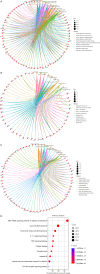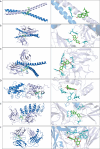Interpreting the pharmacological mechanisms of Juanbi recipe on rheumatoid arthritis through network pharmacology, molecular docking
- PMID: 39114420
- PMCID: PMC11304091
- DOI: 10.21037/aoj-23-72
Interpreting the pharmacological mechanisms of Juanbi recipe on rheumatoid arthritis through network pharmacology, molecular docking
Abstract
Background: Traditional Chinese medicine (TCM) offers the advantage of effectively relieving rheumatoid arthritis (RA) with minimal side effects. The Juanbi recipe is a commonly utilized TCM treatment for RA, yet its pharmacological mechanism remains unclear. Network pharmacology serves as an effective tool for identifying pharmaceutical ingredients and potential therapeutic targets of TCM, thereby uncovering its mechanisms. This study aimed to identify the core target genes and explore the mechanisms underlying the treatment of RA with the Juanbi recipe.
Methods: This study adopted the method of network pharmacology to filter key gene targets of Juanbi recipe in RA treatment. Single-cell ribonucleic acid (RNA) sequencing data was used to screen the key genes to form the core genes of Juanbi recipe in RA treatment. The molecular docking technique was used to verify the core target genes and explore the mechanisms of Juanbi recipe in RA treatment. The RA model of mice was induced by the collagen-induced arthritis and the effect of Juanbi recipe was evaluated by intragastric administrating of extraction of Juanbi recipe. Enzyme linked immunosorbent assay was used to analysis serum inflammatory factors. Hematoxylin and eosin staining was used to evaluate inflammation and immunohistochemical (IHC) staining was used to evaluate core target genes and pathways in synovium of ankle.
Results: This study screened out 281 active molecules in Juanbi recipe, found 105 key target genes of Juanbi recipe in RA treatment, and drew an "ingredient - molecule - gene" diagram. Juanbi recipe reduced the levels of serum interleukin (IL)-1 and IL-6, the inflammatory infiltration in synovium, demonstration that Juanbi recipe reduced both systemic and synovial inflammatory response. Single cell RNA sequencing data were used to select six core target genes and six core active molecules of Juanbi recipe in RA treatment. The pathways of Juanbi recipe in RA treatment involved in activator protein-1 (AP-1) and nuclear factor kappa B (NF-κB) pathway. Results of western blot and IHC staining showed that Juanbi recipe decreased the expressions of c-jun and p65, which demonstrated that Juanbi recipe inhibited the expression of AP-1 and NF-κB pathway in RA.
Conclusions: The core active molecules of Juanbi recipe could inhibit key factors of AP-1 and NF-κB pathway to inhibit the inflammation, which played a protective role in RA.
Keywords: Juanbi recipe; Rheumatoid arthritis (RA); activator protein-1 (AP-1); network pharmacology; nuclear factor kappa B (NF-κB).
2024 Annals of Joint. All rights reserved.
Conflict of interest statement
Conflicts of Interest: All authors have completed the ICMJE uniform disclosure form (available at https://aoj.amegroups.com/article/view/10.21037/aoj-23-72/coif). The authors have no conflicts of interest to declare.
Figures









Similar articles
-
Integrated Network Pharmacology and Experimental Approach to Investigate the Protective Effect of Jin Gu Lian Capsule on Rheumatoid Arthritis by Inhibiting Inflammation via IL-17/NF-κB Pathway.Drug Des Devel Ther. 2023 Dec 13;17:3723-3748. doi: 10.2147/DDDT.S423022. eCollection 2023. Drug Des Devel Ther. 2023. PMID: 38107658 Free PMC article.
-
Discovery and validation of anti-arthritic ingredients and mechanisms of Qingfu Juanbi Tang, a Chinese herbal formulation, on rheumatoid arthritis.J Ethnopharmacol. 2024 Jul 15;329:118140. doi: 10.1016/j.jep.2024.118140. Epub 2024 Mar 31. J Ethnopharmacol. 2024. PMID: 38565409
-
Exploring the pharmacological mechanisms and key active ingredients of total flavonoids from Lamiophlomis rotata (Benth.) Kudo against rheumatoid arthritis based on multi-technology integrated network pharmacology.J Ethnopharmacol. 2023 Dec 5;317:116850. doi: 10.1016/j.jep.2023.116850. Epub 2023 Jun 27. J Ethnopharmacol. 2023. PMID: 37385573
-
[Effect of Juanbi Qianggu Formula on biological behaviors of fibroblast-like synoviocytes in rheumatoid arthritis by regulating FGFR1 signaling pathway based on network pharmacology and cell function experiments].Zhongguo Zhong Yao Za Zhi. 2023 Sep;48(18):4864-4873. doi: 10.19540/j.cnki.cjcmm.20230320.406. Zhongguo Zhong Yao Za Zhi. 2023. PMID: 37802828 Chinese.
-
Targeting immunometabolism by active ingredients derived from traditional Chinese medicines for treatment of rheumatoid arthritis.Chin Herb Med. 2021 Sep 20;13(4):451-460. doi: 10.1016/j.chmed.2021.09.005. eCollection 2021 Oct. Chin Herb Med. 2021. PMID: 36119361 Free PMC article. Review.
References
-
- Fraenkel L, Bathon JM, England BR, et al. 2021 American College of Rheumatology Guideline for the Treatment of Rheumatoid Arthritis. Arthritis Rheumatol 2021;73:1108-23. - PubMed
LinkOut - more resources
Full Text Sources
Research Materials
Miscellaneous
